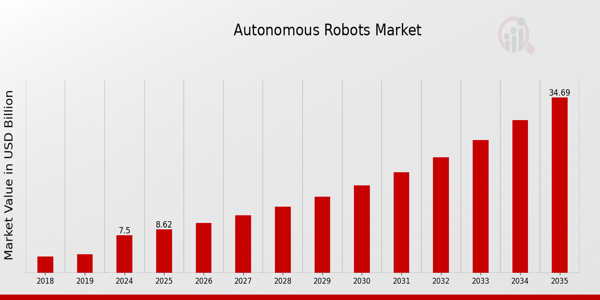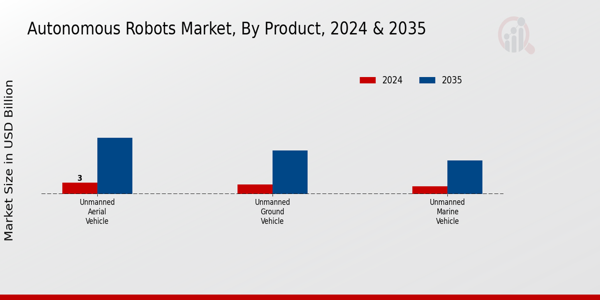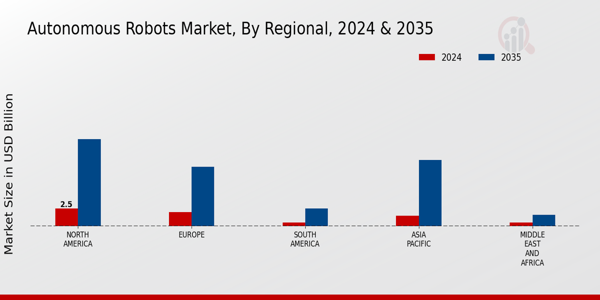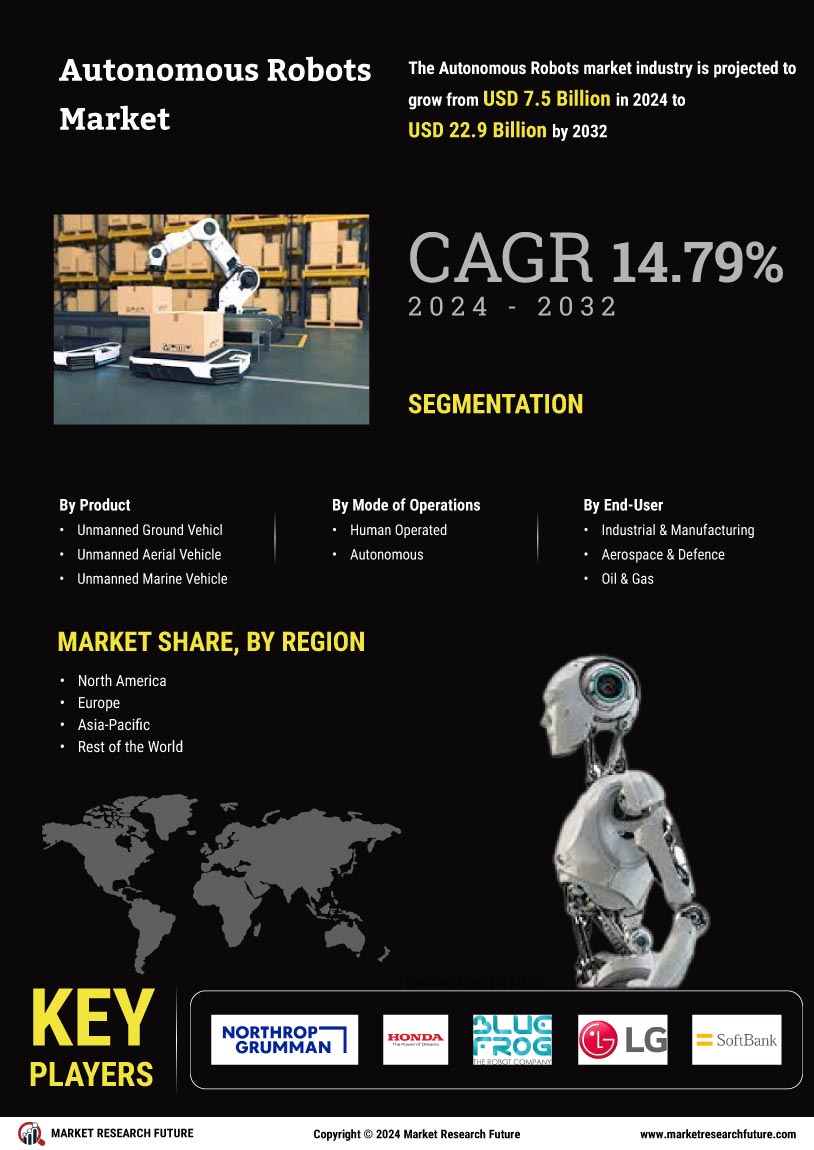Autonomous Robots Market Summary
As per Market Research Future Analysis, the Global Autonomous Robots Market was valued at USD 6.5 Billion in 2023 and is projected to grow from USD 7.5 Billion in 2024 to USD 34.64 Billion by 2035, with a CAGR of 14.94% during the forecast period. The market is driven by the increasing demand for robots in sectors like healthcare and logistics, alongside the growing adoption of collaborative robots (cobots) that enhance human-robot interaction and productivity. The unmanned aerial vehicles segment leads the market, accounting for 47% of revenue, while the logistics and warehouse sector is the largest end-user. North America dominates the market due to rising e-commerce sales and significant investments in automation.
Key Market Trends & Highlights
The Autonomous Robots Market is witnessing significant growth driven by technological advancements and increasing automation across various sectors.
- Market Size in 2023: USD 6.5 Billion
- Projected Market Size by 2032: USD 34.64 Billion
- CAGR from 2025 to 2035: 14.94%
- Unmanned Aerial Vehicles account for 47% of market revenue
Market Size & Forecast
2023 Market Size: USD 6.5 Billion
2024 Market Size: USD 7.5 Billion
2035 Market Size: USD 34.64 Billion
CAGR (2025-2035): 14.94%
Largest Regional Market Share in 2024: North America
Major Players
Key players include Teledyne FLIR, Geek+, Northrop Grumman, Honda Motor, and Amazon Robotics.
Key Autonomous Robots Market Trends Highlighted
The Autonomous Robots Market is growing quickly because of new technology and more people using them in different fields. The growing need for automation in fields like manufacturing, logistics, and healthcare is one of the main things driving the industry. Companies are buying autonomous robots that can do jobs more consistently than people because they need to be more efficient and accurate. Also, robots are becoming better at learning and adapting to their surroundings due to improvements in artificial intelligence and machine learning. This makes them more useful in real-life situations.
There are many chances to be had in areas where there are not enough workers, including in unsafe factories or caring for older people.
In these situations, using autonomous robots can not only meet the need for workers, but it may also ease safety concerns by taking on dangerous duties. The worldwide drive for smart factories and Industry 4.0 projects is also making autonomous robots more useful by increasing productivity and lowering operating expenses. There has been a recent trend toward more attention on collaborative robots, or cobots, which are made to cooperate with people. These systems use the best parts of both people and machines to make production and assembly lines run better.
The constant improvement of sensors and networking tools is changing the world, making it possible for robots to work well in changing surroundings.
As governments and businesses throughout the world realize how important automation is, they are putting more money into infrastructure to support these technologies. This will make it easier for autonomous robots to be used by a lot more people.

Source: Primary Research, Secondary Research, MRFR Database and Analyst Review
Autonomous Robots Market Drivers
Increased Demand for Automation Across Industries
The Autonomous Robots Market Industry is experiencing significant growth driven by an increasing demand for automation across various industries, including manufacturing, logistics, and healthcare. According to Industry data, about 67% of companies in manufacturing are investing in automation technologies, highlighting a trend toward increased efficiency and productivity.
Organizations like the International Federation of Robotics (IFR) report that industrial robots shipments are projected to increase from 200,000 units in 2022 to over 500,000 units by 2025, demonstrating the growing reliance on robots for operational tasks in the global market.This trend is expected to significantly boost the adoption of autonomous robots, as companies seek to reduce human error and enhance operational performance amidst labor shortages and rising operational costs.
Technological Advancements in Robotics
Technological advancements in artificial intelligence, machine learning, and sensor technology are driving the Autonomous Robots Market Industry forward. With the growing capabilities of robots to perform complex tasks, their applications are expanding beyond traditional areas. For example, a report from the World Economic Forum indicates that the global stock of robots is expected to increase at a compound annual growth rate of 20% from 2020 to 2025, showcasing how innovations are making autonomous robots more efficient and capable.
Major companies like Boston Dynamics and KUKA are leading developments in robot technologies, facilitating breakthroughs in automation that contribute to market growth.
Growing E-Commerce Sector
The booming e-commerce sector is significantly influencing the growth of the Autonomous Robots Market Industry. The surge in online shopping has heightened the demand for efficient logistics and supply chain solutions. A report from the United Nations Conference on Trade and Development (UNCTAD) indicates that global e-commerce sales reached approximately 26.7 USD Trillion in 2019, representing a 4% increase from the previous year.
This trend has prompted retail companies to invest in autonomous delivery robots and warehouse automation systems to keep pace with consumer demands.Firms like Amazon are increasingly incorporating autonomous robots into their operations to improve fulfillment speed and accuracy, thus driving rapid market adoption.
Supportive Government Regulations and Initiatives
Governments around the globe are increasingly recognizing the importance of robotics and automation in enhancing economic competitiveness, leading to supportive regulations and initiatives. For example, the European Union has launched the Horizon 2020 initiative, dedicated to funding research and innovation in robotics and automation. This initiative aims to create opportunities for innovation in autonomous technologies with an allocated budget of 80 billion euros over seven years.
Such government support fosters an environment conducive to the development of autonomous robots, bolstering the Autonomous Robots Market Industry as innovations are translated into viable market solutions.
Autonomous Robots Market Segment Insights
Autonomous Robots Market Product Insights
The Autonomous Robots Market revenue has shown remarkable growth, with the market expected to reach a valuation of 7.5 USD Billion by 2024, rising significantly to 34.64 USD Billion by 2035. Within this extensive market segmentation, the product categories of Unmanned Ground Vehicles, Unmanned Aerial Vehicles, and Unmanned Marine Vehicles play pivotal roles.
In 2024, the Unmanned Ground Vehicle market is valued at 2.5 USD Billion and is projected to burgeon to 11.34 USD Billion by 2035, indicating its potential to dominate the landscape due to its applications in defense, logistics, and transportation.The Unmanned Aerial Vehicle category, valued at 3.0 USD Billion in 2024, is forecasted to soar to 14.56 USD Billion in 2035, demonstrating its significant role in surveillance, agriculture, and disaster management.
Furthermore, the Unmanned Marine Vehicle segment holds a valuation of 2.0 USD Billion in 2024 and is anticipated to reach 8.74 USD Billion by 2035, underlining its importance in various maritime applications including oceanographic research and underwater exploration. The majority holding among these three categories is captured by Unmanned Aerial Vehicles, which find widespread usage in both commercial and military operations, making them essential in today's rapidly advancing technological landscape.The Autonomous Robots Market Statistics reflect a growing trend towards automation, driven by factors such as increasing demand for efficiency, safety concerns, and the potential for reduced labor costs.
However, challenges like regulatory concerns and high initial investment costs may act as a barrier to growth in certain segments. Nonetheless, opportunities in emerging markets present avenues for future expansion, as industries increasingly turn to automation to meet their operational needs. Overall, the market growth continues to be buoyed by technological advancements and increased investments in Research and Development, facilitating exciting innovations across all categories of autonomous robots.

Source: Primary Research, Secondary Research, MRFR Database and Analyst Review
Autonomous Robots Market Mode of Operations Insights
The Autonomous Robots Market is projected to reach a valuation of 7.5 USD Billion by the year 2024 and is expected to grow significantly. Within this market, the Mode of Operations plays a crucial role, primarily categorized into Human Operated and Autonomous systems. The Autonomous mode particularly accounts for a larger share of the Autonomous Robots Market revenue as it enhances operational efficiency and minimizes human intervention, thereby reducing operational costs.
The human-operated segment remains essential in tasks requiring manual oversight or complex decision-making, making it indispensable for certain industries.This dual approach reflects a growing trend towards hybrid models that combine human expertise with robotic efficiency. As industries increasingly adopt automation, market growth is driven by technological advancements in artificial intelligence and machine learning, alongside the need for increased productivity in various sectors globally. However, companies must navigate challenges such as integration into existing workflows and addressing the workforce implications of automation. Overall, the Autonomous Robots Market segmentation reflects a dynamic landscape with significant opportunities for innovation and growth.
Autonomous Robots Market End-User Insights
The Autonomous Robots Market is poised for substantial growth as it encompasses various End-User categories, reflecting a versatile application landscape. By 2024, the market is expected to achieve a valuation of 7.5 USD Billion, with diverse sectors contributing to this growth trajectory. Notably, the Industrial and Manufacturing sector is significant, leveraging automation for efficiency and productivity. Aerospace and Defence also dominate, driven by a growing need for precision and risk mitigation in operations. The Oil and Gas sector utilizes autonomous robots for exploration and maintenance tasks, ensuring safety and reducing human intervention.
Logistics and Warehouse operations increasingly implement these technologies to streamline supply chain processes, while the Medical and Healthcare industry benefits from robots in surgeries and patient care. Mining and Minerals sectors rely on autonomous robots for efficiency and safety in extraction, as Forest and Agriculture utilize them for monitoring and resource management. The Power and Energy sector finds value in these robots for inspection and maintenance tasks, ensuring reliable energy production. Overall, the Autonomous Robots Market segmentation reflects a strong potential for innovation and application across multiple industries, driven by technological advancements and increasing automation needs.
Autonomous Robots Market Regional Insights
The Regional analysis of the Autonomous Robots Market shows a dynamic landscape with varied valuations across different areas. In 2024, North America stands as a significant player, valued at 2.5 USD Billion and projected to grow to 12.5 USD Billion by 2035, thus dominating the market due to its advanced technology adoption and extensive R&D initiatives. Europe follows with a valuation of 2.0 USD Billion in 2024, anticipated to reach 8.5 USD Billion in 2035, benefiting from strong industrial automation trends and government investments.
Meanwhile, Asia Pacific, valued at 1.5 USD Billion in 2024 and expected to grow to 9.5 USD Billion by 2035, highlights its growing manufacturing base and increased demand in sectors such as logistics and healthcare.South America and the Middle East and Africa present smaller market sizes, with values of 0.5 USD Billion and 1.6 USD Billion respectively in 2035, reflecting their nascent stages in adopting autonomous robotics technology. However, their growth potential is significant, driven by rising economic developments and the need for innovative solutions in various industries.
Overall, the Autonomous Robots Market segmentation illustrates how each region plays a vital role in contributing to the market growth, with specific dynamics influencing their dominant or emerging positions.

Source: Primary Research, Secondary Research, MRFR Database and Analyst Review
Autonomous Robots Market Key Players and Competitive Insights
The Autonomous Robots Market is witnessing a transformative evolution driven by advancements in technology, increasing demand for automation across various industries, and heightened interest in artificial intelligence and machine learning. As industries strive for efficiency, productivity, and improved operational capabilities, the competitive landscape of autonomous robotics continues to expand, with numerous players offering innovative solutions tailored to meet diverse consumer needs.
With applications ranging from manufacturing, logistics, and healthcare to agriculture and exploration, understanding the competitive dynamics becomes crucial for stakeholders aiming to capitalize on market opportunities. This sector is characterized by a blend of established companies and emerging start-ups, each bringing unique technologies and strategies to enhance their market positioning.ABB stands out in the Autonomous Robots Market due to its extensive experience and expertise in automation and robotics. Recognized for its sophisticated technology solutions, ABB offers key products that include industrial robots, collaborative robots, and software solutions that enhance automation processes.
Its strong global footprint reflects a well-established network that spans various industrial sectors, giving it a competitive edge over market players.
The company emphasizes continuous innovation and is actively engaged in research initiatives that bolster its product offerings. Recent mergers and acquisitions have positioned ABB to enhance its technological capabilities and expand its market reach. By leveraging synergies from these strategic decisions, ABB has bolstered its ability to deliver comprehensive automation solutions, catering to the growing demands of modern industries worldwide.
Key Companies in the Autonomous Robots Market Include
- ABB
- Autonomous Solutions
- KUKA
- SoftBank Robotics
- Bluefin Robotics
- DroneDeploy
- Clearpath Robotics
- iRobot
- Boston Dynamics
- Ecovacs Robotics
- Yaskawa Electric
- Fanuc
- Amazon Robotics
Autonomous Robots Market Developments
-
Q3 2025: Robot orders in North America up by 4.3 percent compared with last year The Association for Advancing Automation (A3) reported that North American robot orders increased by 4.3% and revenue rose 7.5% in the first half of 2025, with strong growth in the automotive, electronics, and logistics sectors.
Autonomous Robots Market Segmentation Insights
Autonomous Robots Market Product Outlook
- Unmanned Ground Vehicle
- Unmanned Aerial Vehicle
- Unmanned Marine Vehicle
Autonomous Robots Market Mode of Operations Outlook
- Human Operated
- Autonomous
Autonomous Robots Market End-User Outlook
- Industrial & Manufacturing
- Aerospace & Defence
- Oil & Gas
- Logistics & Warehouse
- Medical & Healthcare
- Mining & Minerals
- Forest & Agriculture
- Power & Energy
- Others
Autonomous Robots Market Regional Outlook
- North America
- Europe
- South America
- Asia Pacific
- Middle East and Africa
|
Report Attribute/Metric
|
Details
|
|
Market Size 2023
|
6.5(USD Billion)
|
|
Market Size 2024
|
7.5(USD Billion)
|
|
Market Size 2035
|
34.64(USD Billion)
|
|
Compound Annual Growth Rate (CAGR)
|
14.94% (2025 - 2035)
|
|
Report Coverage
|
Revenue Forecast, Competitive Landscape, Growth Factors, and Trends
|
|
Base Year
|
2024
|
|
Market Forecast Period
|
2025 - 2035
|
|
Historical Data
|
2019 - 2024
|
|
Market Forecast Units
|
USD Billion
|
|
Key Companies Profiled
|
ABB, Autonomous Solutions, KUKA, SoftBank Robotics, Bluefin Robotics, DroneDeploy, Clearpath Robotics, iRobot, Boston Dynamics, Ecovacs Robotics, Yaskawa Electric, Fanuc, Amazon Robotics
|
|
Segments Covered
|
Product, Mode of Operations, End-User, Regional
|
|
Key Market Opportunities
|
Increased demand in logistics automation, Advancements in AI and machine learning, Expanding healthcare applications for robots, Growth in agricultural automation solutions, Rising interest in consumer robotics.
|
|
Key Market Dynamics
|
Technological advancements, Increasing labor costs, Growing safety regulations, Expanding industrial applications, Enhancing customer experience
|
|
Countries Covered
|
North America, Europe, APAC, South America, MEA
|
Frequently Asked Questions (FAQ):
The Autonomous Robots Market is expected to be valued at 7.5 USD Billion in the year 2024.
By 2035, the Autonomous Robots Market is projected to reach a value of 34.64 USD Billion.
The expected compound annual growth rate (CAGR) for the Autonomous Robots Market is 14.94% during the period from 2025 to 2035.
North America is anticipated to dominate the Autonomous Robots Market, projected to be valued at 12.5 USD Billion by 2035.
The Unmanned Aerial Vehicle segment of the Autonomous Robots Market is valued at 3.0 USD Billion in the year 2024.
The Unmanned Marine Vehicle segment is expected to experience significant growth, contributing to the overall CAGR of 14.94% from 2025 to 2035.
Key players in the Autonomous Robots Market include companies such as ABB, KUKA, Boston Dynamics, and Amazon Robotics.
In 2035, the Autonomous Robots Market in Europe is expected to be valued at 8.5 USD Billion.
The Autonomous Robots Market value in South America is projected to reach 2.5 USD Billion by 2035.
The Unmanned Ground Vehicle segment is expected to attain a market value of 11.34 USD Billion by the year 2035.

















